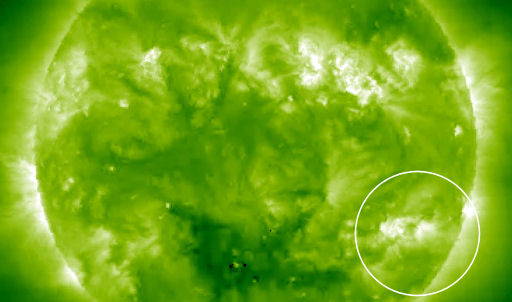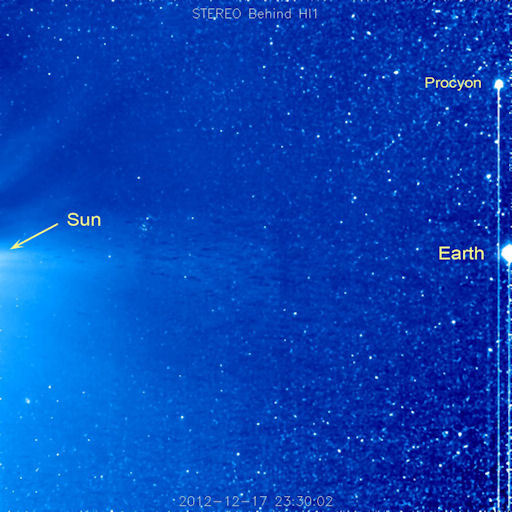CHANCE OF STORMS: NOAA forecasters estimate a 10% to 20% chance of polar geomagnetic storms on Dec. 24th in response to a CIR or "corotating interaction region." A CIR is a boundary between fast- and slow-moving streams in the solar wind. Crossing a CIR, as Earth will do on Christmas Eve, can spark magnetic storms and auroras. Aurora alerts: text, voice.
FARSIDE ERUPTION: No strong flares have issued from the sun in weeks, but solar activity might not be as low as it seems. The farside of the sun is increasingly restless. On Dec. 21st, multiple CMEs flew over the edge of the solar disk, and today NASA's STEREO-A spacecraft observed a filament erupting on the farside. The blast site is circled in this extreme ultraviolet image taken on Dec. 23rd at 11:15 UT:
This activity suggests that the long-term forecast could be stormy. In one to two weeks, active regions currently on the farside will turn toward Earth, possibly sending some flares and CMEs our way. Solar flare alerts: text, voice.
Realtime Space Weather Photo Gallery
SOLAR SPACE TELESCOPE SEES EARTH: NASA's STEREO-B spacecraft can now see our home planet in its HI1 telescope. HI stands for "Heliospheric Imager." The telescope is designed to track gusts of solar wind and solar storms all the way from the sun to Earth. This image, captured on Dec. 17th, shows Earth and the edge of the sun's corona in a single snapshot:
Earth is moving into the Heliospheric Imager's field of view because the twin STEREO probes are moving around the farside of the sun, which gives them a better view of the sun-Earth system: diagram. Soon Earth will be visible in STEREO-A's HI1 telescope and eventually in the coronagraphs as well.
The STEREO probes have two wider-field heliospheric imagers, too: HI2-A and HI2-B. Earth has been visible in the HI2 telescopes since launch in 2007, but this is the first time our planet has been visible in either of the HI1 telescopes, which can see regions of space closer to the sun. This development will give researchers a better view of solar storms engulfing Earth and could lead to improvements in space weather forecasting.

![]()
Solar wind
speed: 329.4 km/sec
density: 4.1 protons/cm3
explanation | more data
Updated: Today at 2347 UT
![]()
X-ray Solar Flares
6-hr max: B9 2044 UT Dec23
24-hr: C1 0230 UT Dec23
explanation | more data
Updated: Today at: 2300 UT
![]()
![]()
![]()
Daily Sun: 23 Dec 12
![]()
![]()
Sunspot 1635 is crackling with low-level C-flares. Credit: SDO/HMI
![]()
![]()
![]()
Sunspot number: 67
What is the sunspot number?
Updated 22 Dec 2012
Spotless Days
Current Stretch: 0 days
2012 total: 0 days (0%)
2011 total: 2 days (<1%)
2010 total: 51 days (14%)
2009 total: 260 days (71%)
Since 2004: 821 days
Typical Solar Min: 486 days
Update 22 Dec 2012
The Radio Sun
10.7 cm flux: 115 sfu
explanation | more data
Updated 22 Dec 2012
![]()
![]()
![]()
Current Auroral Oval:
![]()
Switch to: Europe, USA, New Zealand, Antarctica
Credit: NOAA/POES
![]()
![]()
![]()
Planetary K-index
Now: Kp= 0 quiet
24-hr max: Kp= 1 quiet
explanation | more data
![]()
Interplanetary Mag. Field
Btotal: 4.1 nT
Bz: 0.4 nT north
explanation | more data
Updated: Today at 2347 UT
![]()
![]()
![]()
Coronal Holes: 23 Dec 12
![]()
![]()
Solar wind flowing from this coronal hole should reach Earth on or about Dec. 27th. Credit: SDO/AIA.






